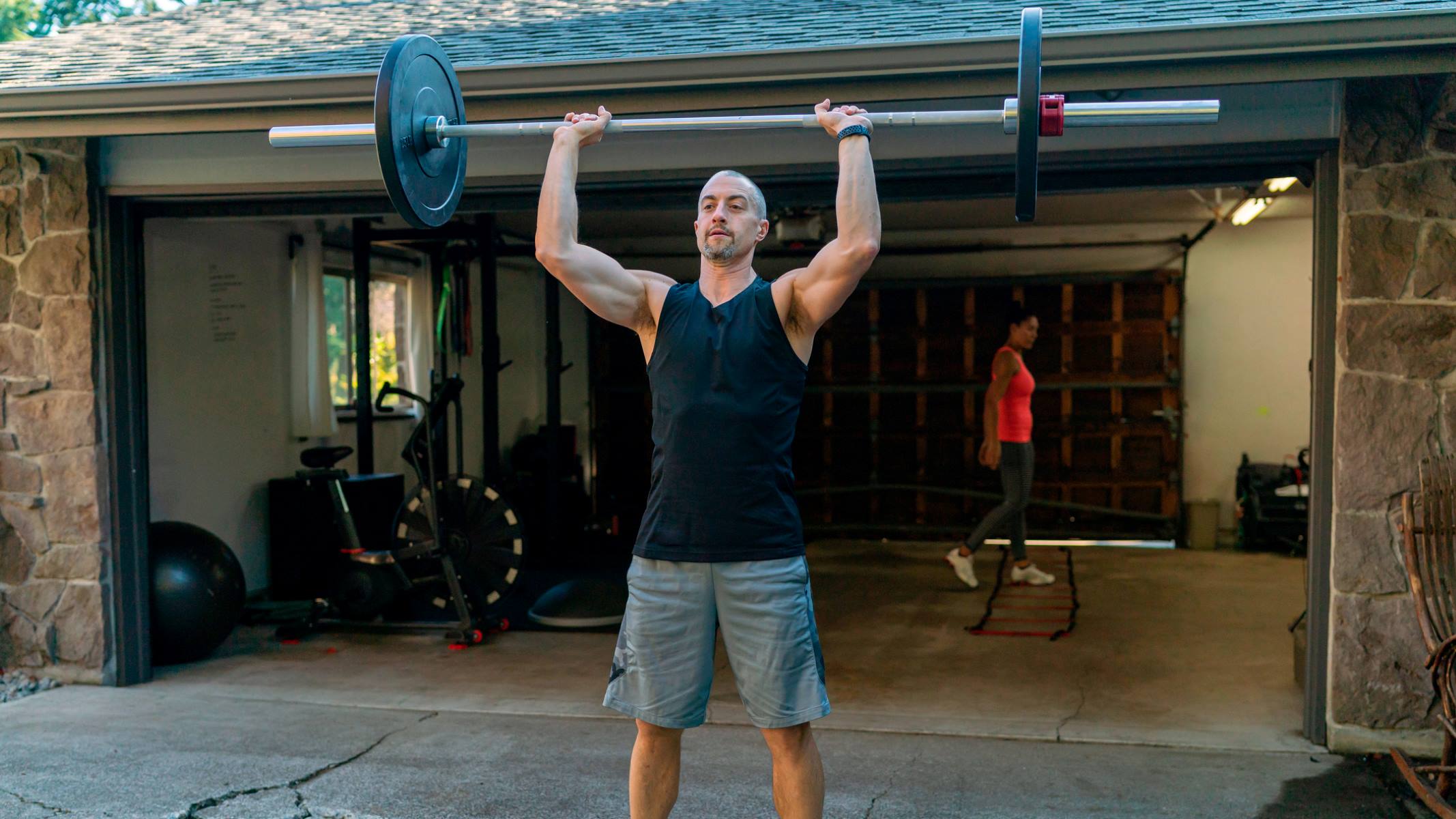Home>Health and Wellness>Dumbbell Vs. Barbell Bench Press: Surprising Strength Difference Revealed!


Health and Wellness
Dumbbell Vs. Barbell Bench Press: Surprising Strength Difference Revealed!
Published: February 7, 2024
Discover the surprising strength difference between dumbbell and barbell bench press exercises in this comprehensive guide to health and wellness. Unlock the secrets to maximizing your workout potential today!
(Many of the links in this article redirect to a specific reviewed product. Your purchase of these products through affiliate links helps to generate commission for Regretless.com, at no extra cost. Learn more)
Table of Contents
Introduction
When it comes to strength training, the debate between dumbbell and barbell bench press has been a topic of fervent discussion among fitness enthusiasts and athletes. Both exercises are fundamental for building upper body strength and muscle mass, but they each offer unique benefits and challenges. Understanding the mechanics, muscle engagement, and strength differences between these two popular exercises is crucial for anyone looking to maximize their workout routine and achieve their fitness goals. In this article, we will delve into the intricacies of the dumbbell and barbell bench press, uncovering the surprising disparities in strength and shedding light on the distinct advantages and drawbacks of each exercise. Whether you're a seasoned lifter or a novice gym-goer, this exploration will provide valuable insights that can elevate your training regimen and help you make informed decisions about which exercise best suits your fitness objectives. So, let's embark on this enlightening journey into the world of strength training and discover the remarkable disparities between the dumbbell and barbell bench press!
The Mechanics of Dumbbell and Barbell Bench Press
The dumbbell and barbell bench press are two quintessential exercises that form the cornerstone of upper body strength training. Understanding the mechanics of these exercises is crucial for executing them with precision and maximizing their effectiveness.
Dumbbell Bench Press Mechanics
When performing the dumbbell bench press, the individual lies on a flat bench with a dumbbell in each hand. The palms face forward as the weights are lifted to shoulder level. The movement involves a controlled descent of the dumbbells towards the chest, followed by an explosive press upwards to the starting position. This exercise requires a high degree of stability and control, as each arm operates independently, engaging the stabilizing muscles to a greater extent than the barbell bench press.
Barbell Bench Press Mechanics
Conversely, the barbell bench press is executed with the individual lying on a bench, gripping the barbell with both hands at a slightly wider than shoulder-width distance. The movement entails lowering the barbell to the chest and then pressing it back up to the starting position. Unlike the dumbbell bench press, the barbell variation necessitates symmetrical movement, engaging both arms simultaneously and placing a greater emphasis on overall chest and triceps strength.
Key Differences
One notable distinction between the two exercises lies in the range of motion. The dumbbell bench press allows for a greater range of motion as each arm operates independently, accommodating individual shoulder mobility and enabling a deeper stretch at the bottom of the movement. On the other hand, the barbell bench press restricts the range of motion to a certain extent due to the fixed grip on the barbell.
Understanding the mechanics of these exercises not only enhances their execution but also underscores the unique challenges and benefits they offer. Whether you prefer the unilateral control of the dumbbell bench press or the symmetrical power of the barbell variation, mastering the mechanics of both exercises is essential for optimizing your strength training routine.
Muscles Worked in Dumbbell and Barbell Bench Press
The dumbbell and barbell bench press are renowned for their effectiveness in targeting a wide array of upper body muscles, making them indispensable components of strength training routines. Understanding the specific muscles engaged during these exercises is pivotal for comprehending their impact on overall muscle development and functional strength.
Muscles Engaged in Dumbbell Bench Press
The dumbbell bench press places significant emphasis on the pectoralis major, the large chest muscle responsible for horizontal adduction of the arms. As the dumbbells are lowered towards the chest, the pectoralis major undergoes eccentric contraction, effectively lengthening under load. The subsequent concentric contraction during the pressing phase activates the pectoralis major to propel the dumbbells upwards. Additionally, the anterior deltoids, or front shoulder muscles, play a vital role in stabilizing and assisting the pectoralis major throughout the movement. This exercise also engages the triceps brachii, the primary extensor muscles of the elbow, as they work synergistically with the chest and shoulders to execute the pressing motion. Furthermore, the stabilizing muscles, including the serratus anterior and the rotator cuff muscles, are actively involved in maintaining shoulder stability and controlling the movement of the dumbbells.
Muscles Engaged in Barbell Bench Press
Similarly, the barbell bench press effectively targets the pectoralis major, eliciting substantial muscle activation during both the eccentric and concentric phases of the exercise. The triceps brachii and anterior deltoids are also prominently engaged, functioning synergistically with the pectoralis major to facilitate the pressing motion. Moreover, the barbell bench press places a greater emphasis on overall chest development, as the symmetrical movement pattern necessitates coordinated activation of the pectoral muscles on both sides of the body. This exercise also recruits the trapezius and rhomboid muscles in the upper back to stabilize the shoulders and maintain proper scapular positioning throughout the movement. Additionally, the engagement of the triceps and deltoids in the barbell bench press contributes to enhanced upper body strength and stability.
Key Differences in Muscle Engagement
While both exercises primarily target the chest, shoulders, and triceps, the dumbbell bench press offers the unique advantage of engaging the stabilizing muscles to a greater extent due to the independent movement of each arm. This not only promotes balanced muscle development but also enhances shoulder stability and control. On the other hand, the barbell bench press emphasizes symmetrical muscle activation, fostering overall chest development and strength.
Understanding the intricate interplay of muscles during the dumbbell and barbell bench press underscores the comprehensive upper body engagement offered by these exercises. Whether you seek to enhance chest development, shoulder stability, or triceps strength, incorporating both variations into your strength training regimen can yield significant benefits and contribute to a well-rounded upper body musculature.
The Strength Difference: Dumbbell vs. Barbell Bench Press
When comparing the strength difference between the dumbbell and barbell bench press, it's essential to consider the unique challenges and advantages offered by each exercise. While both variations are instrumental in building upper body strength and muscle mass, they present distinct differences in terms of the amount of weight lifted, muscle engagement, and overall strength development.
The barbell bench press is renowned for its capacity to handle heavier weights compared to the dumbbell bench press. The symmetrical movement pattern and the ability to recruit both arms simultaneously allow lifters to exert greater force and power, facilitating the lifting of heavier loads. This emphasis on heavy lifting contributes to enhanced overall upper body strength, particularly in the chest, shoulders, and triceps. The barbell bench press serves as a cornerstone for strength development, enabling lifters to progressively increase the weight lifted, thereby fostering muscle hypertrophy and strength gains.
On the other hand, the dumbbell bench press, while typically involving lighter weights compared to the barbell variation, presents a unique challenge in terms of stability and control. The independent movement of each arm necessitates greater stabilization and coordination, demanding heightened muscle activation from the stabilizing muscles, including the rotator cuff and serratus anterior. This increased demand on stabilizing muscles not only enhances shoulder stability and control but also contributes to improved overall upper body functional strength. Additionally, the greater range of motion afforded by the dumbbell bench press allows for a deeper stretch in the chest muscles, promoting muscle elongation and flexibility.
While the barbell bench press excels in facilitating heavy lifting and maximal strength development, the dumbbell bench press offers a comprehensive approach to upper body strength by emphasizing stability, control, and unilateral strength development. Incorporating both exercises into a well-rounded strength training regimen can yield significant benefits, addressing both maximal strength and functional stability.
In essence, the strength difference between the dumbbell and barbell bench press lies in their unique approaches to upper body strength development. While the barbell variation emphasizes maximal strength and power, the dumbbell bench press prioritizes stability, control, and unilateral strength, offering a holistic approach to upper body strength training. Understanding and leveraging the strengths of each exercise can empower individuals to optimize their strength training routine and achieve comprehensive upper body strength and muscle development.
Benefits and Drawbacks of Dumbbell and Barbell Bench Press
The dumbbell and barbell bench press are revered for their efficacy in building upper body strength and muscle mass, each offering a unique set of benefits and drawbacks that warrant careful consideration when incorporating them into a strength training regimen.
Benefits of Dumbbell Bench Press
1. Unilateral Strength Development:
The independent movement of each arm during the dumbbell bench press fosters unilateral strength development, addressing muscle imbalances and promoting balanced muscle development. This is particularly advantageous for individuals rehabilitating from injuries or seeking to enhance functional strength and stability.
2. Enhanced Stability and Control:
The need for greater stabilization and coordination in the dumbbell bench press engenders improved shoulder stability and control, contributing to injury prevention and overall upper body functional strength. The engagement of stabilizing muscles, such as the rotator cuff and serratus anterior, fortifies the shoulder girdle and enhances joint stability.
3. Greater Range of Motion:
The dumbbell bench press allows for a broader range of motion compared to its barbell counterpart, facilitating a deeper stretch in the chest muscles and promoting muscle elongation and flexibility. This can be particularly beneficial for individuals aiming to improve mobility and optimize muscle activation.
Drawbacks of Dumbbell Bench Press
1. Limitation in Handling Heavy Weights:
While the dumbbell bench press offers unique advantages in terms of stability and control, it may present limitations in handling heavier weights compared to the barbell variation. This can potentially hinder maximal strength development for individuals focused on powerlifting or strength competitions.
2. Increased Demand on Stabilizing Muscles:
The emphasis on stability and control in the dumbbell bench press necessitates heightened activation of the stabilizing muscles, which may lead to premature fatigue and impact the lifter's ability to perform additional upper body exercises effectively.
Benefits of Barbell Bench Press
1. Maximal Strength Development:
The barbell bench press excels in facilitating heavy lifting and maximal strength development, making it an indispensable exercise for individuals aiming to increase overall upper body strength and muscle mass. The symmetrical movement pattern allows for the recruitment of both arms simultaneously, enabling lifters to exert greater force and handle heavier loads.
2. Progressive Overload:
The barbell bench press provides a platform for progressive overload, allowing individuals to systematically increase the weight lifted, thereby promoting muscle hypertrophy and strength gains. This progressive approach to strength development is pivotal for individuals seeking continuous improvement in their training regimen.
Drawbacks of Barbell Bench Press
1. Limited Unilateral Focus:
Unlike the dumbbell bench press, the barbell variation lacks the emphasis on unilateral strength development, potentially leading to asymmetries in muscle strength and coordination if not supplemented with unilateral exercises.
2. Reduced Range of Motion:
The fixed grip on the barbell restricts the range of motion in the barbell bench press, which may limit the stretch and activation of certain muscle fibers in the chest, potentially impacting overall muscle development and flexibility.
In summary, both the dumbbell and barbell bench press offer distinct advantages and drawbacks, catering to diverse training objectives and individual preferences. Understanding the nuanced benefits and limitations of each exercise empowers individuals to make informed decisions when designing their strength training routine, ultimately optimizing their upper body strength and muscle development.
Conclusion
In conclusion, the comparison between the dumbbell and barbell bench press reveals intriguing disparities in strength, muscle engagement, and overall effectiveness in upper body training. The mechanics of these exercises underscore the unique challenges and advantages they offer, from the independent movement of each arm in the dumbbell bench press to the symmetrical power of the barbell variation. Understanding the distinct muscle engagement in these exercises sheds light on their impact on chest, shoulder, and triceps development, emphasizing the comprehensive upper body engagement provided by both variations.
The strength difference between the dumbbell and barbell bench press reflects their distinct approaches to upper body strength development. While the barbell bench press excels in facilitating heavy lifting and maximal strength development, the dumbbell bench press offers a holistic approach by emphasizing stability, control, and unilateral strength. This nuanced comparison underscores the importance of incorporating both exercises into a well-rounded strength training regimen to achieve comprehensive upper body strength and muscle development.
Furthermore, the benefits and drawbacks of the dumbbell and barbell bench press provide valuable insights for individuals seeking to optimize their training regimen. The unilateral strength development and enhanced stability offered by the dumbbell bench press are balanced by its limitations in handling heavy weights, while the barbell bench press's maximal strength development and progressive overload potential are counteracted by its limited unilateral focus and reduced range of motion. These considerations highlight the need for a balanced approach, where both exercises complement each other to address diverse training objectives and individual preferences.
Ultimately, the decision to incorporate the dumbbell or barbell bench press into a strength training routine should be guided by an individual's specific goals, preferences, and any existing physical considerations. By leveraging the strengths of each exercise and understanding their unique contributions to upper body strength development, individuals can tailor their training regimen to optimize muscle growth, functional strength, and overall fitness.
In essence, the comparison between the dumbbell and barbell bench press transcends a mere evaluation of lifting techniques; it serves as a testament to the multifaceted nature of strength training and the diverse pathways to achieving comprehensive upper body strength and muscle development. Whether one gravitates towards the unilateral control of the dumbbell bench press or the symmetrical power of the barbell variation, both exercises stand as pillars of strength training, offering invaluable opportunities for individuals to sculpt a robust and resilient upper body.












